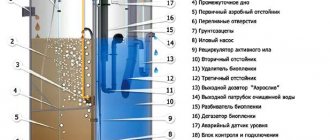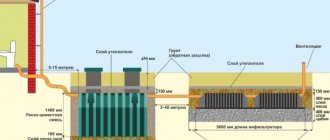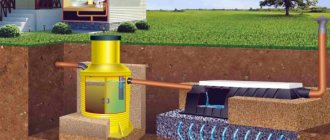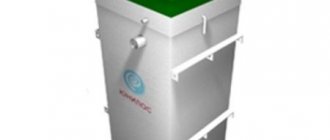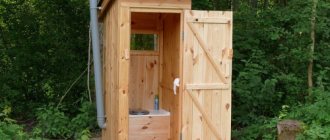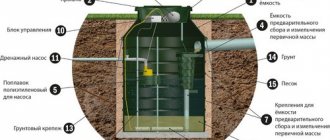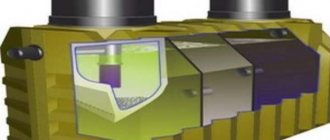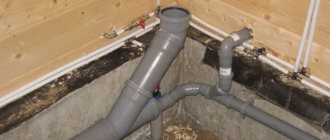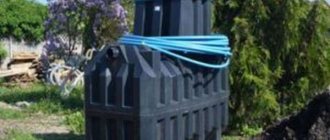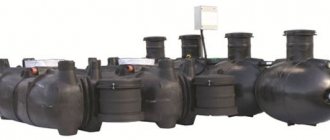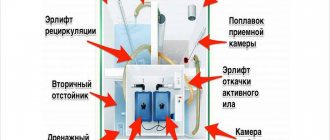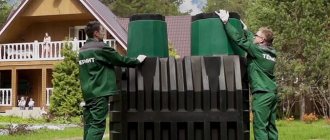If you are the owner of a summer house, then you should be aware of the issue of installing an autonomous sewer system. Quite often, consumers are faced with the problem of choosing a model. Buyers read reviews, from which they are able to understand that among the large assortment of ready-made containers that are presented on the modern market, the DKS septic tank especially stands out. As practice shows, it produces high-quality designs that have many positive features and an affordable price.
Septic tank review
The manufacture of the above-described structures is carried out from sheet polypropylene; its thickness can be equal to the limit from 5 to 8 mm. Such designs are divided into three components (first chamber, second chamber and third chamber). The first compartment is the primary settling tank, the second serves as a secondary settling tank. But in the third chamber there are biofilters.
Wastewater flows through a pipe into the primary settling tank and is separated into light and heavy fractions. The overflow, which connects the second and first settling tanks, is located at a third of the height of the tank. This significantly reduces the impurity content in the second chamber, which is especially true compared to the first.
The process of settling and clarification of sewage continues in the second compartment. The DKS septic tank uses in its work not only mechanical separation of impurities, but also anaerobic digestion technology. The presence of oxygen is not required. During the reaction, methane is released, which is why such structures are called methane tanks. Bacteria that are present in feces take part in the breakdown of contaminants through metabolism. Water seals prevent the spread of unpleasant odors that come from the septic tank.
The movement of clarified wastewater subsequently occurs through the overflow pipe, the water ends up in the biofilter, so mixing is completely excluded. A drip nozzle on the overflow pipe ensures water distribution throughout the brush load. Not so long ago, manufacturers used expanded clay-based loading instead of brushes. On the surface of the former, the water is saturated with oxygen, which contributes to the formation of aerobic bioflora, which develops in favorable conditions.
The biofilter will work normally if the pipe with the head is properly arranged. It is necessary for the supply of air, which participates in the life of aerobic microorganisms. The wastewater that passes through the biofilter ends up in the drainage system; it bypasses the settling tank and the outlet pipe.
The drainage in this scheme is a perforated pipe; through its holes, clarified wastewater penetrates into the soil, where it undergoes infiltration. The sediment is periodically removed through the neck; it first accumulates at the bottom of the first and second compartments. Maintenance and inspection of the system is carried out through the second neck. In winter, to prevent the containers from freezing, it is recommended to deepen the structure using a neck extension kit. It is purchased separately by the consumer.
Principle of operation
Diagram of a device with forced drainage
The process of wastewater treatment in DCS septic tanks occurs in the following sequence:
- Domestic sewage, moving by gravity through the pipeline (4), enters the first compartment of the tank (1) - the primary settling tank. It is where the liquid settles and separates. Solid particles settle to the bottom, fatty components collect on the surface in the form of a film, and the settled liquid ends up in the middle part of the tank. In the first settling tank, the fermentation process begins, as a result of which solid particles of feces turn into sludge. This process occurs thanks to anaerobic bacteria - microorganisms that enter wastewater along with human waste products. Anaerobic bacteria do not require a supply of fresh air to operate. Therefore, an aeration system is not installed in the first settling tank.
- The liquid part of the wastewater flows through the overflow into the second settling tank. The overflow is located at such a height that neither solid particles nor greasy film from the surface enters the second compartment of the container. In the second compartment, the work of anaerobic bacteria continues. The liquid is freed from the remaining suspended particles settling to the bottom, and the purified water flows through a pipe with a sprinkler (4) into the biofilter (located in the upper part of the second settling tank).
- Through the drip sprayer, the liquid enters the biofilter brush loading. The surface of the brush load is populated by another type of microorganisms - aerobic bacteria, capable of living and processing wastewater only with a constant supply of air. The supply of oxygen to the biofilter is provided by ventilation pipes extending from the tank to the surface.
- Completely purified water from the biofilter enters the storage tank (in systems with forced drainage) or into the drainage pipeline (in gravity-flow installations). Water is pumped out of the storage tank using a drainage pump.
General diagram of the operation of a septic tank with a filtration field
Features of different models
The DKS septic tank is presented for sale in several models, each of which is intended for a certain number of people living in the country. If you plan to use the house all year round, then this should be reflected in the choice of design. For example, for the installation of an autonomous sewer system, which is installed at a weekend dacha, a “Mini” septic tank is perfect. Its volume is designed to serve 4 people maximum. The device will process 120 liters of sewage per day.
The “DKS Optimum” septic tank and models DKS-15, DKS-25 differ in their processing capacity per day and the weight of the structures. It is based on polypropylene, which is a lightweight material, so installation of the container does not require the use of special equipment or human effort. The structure is installed in the prepared place. The building allows you to place the structure next to the house.
The septic tank “DKS 15m” and “DKS-25 M” assumes the presence of a storage tank for installing a drainage pump. These options can be used in areas where groundwater levels are high. In winter, these solutions can be used together with a kit that is buried in the soil. Its elements are classified by height and design.
Do-it-yourself sewerage for a summer residence - the main thing is in the details
Content:
1. Sewerage diagram at the dacha 2. Choosing a location for the sewer system at the dacha house 3. Construction of a sewerage system at the dacha 4. Laying sewer pipes 5. Internal sewer network
The main purpose of sewerage in a country house is the collection, purification and further disposal of wastewater generated when water is used for economic and hygienic purposes. Also, a country sewer system for a dacha can cope with the processing of feces. At any dacha where people sometimes live, it is necessary to equip a sewer system, for example, like the one in the photo, which will create normal living conditions.
An important component of civilized life is the presence of sewerage and running water. Residents of apartment buildings do not think about how sewer systems function, since all waste flows into a sewer maintained by city utilities.
Drainage is waste water from sinks, bathtubs, kitchen sinks, and feces from toilets. They are discharged through an internal pipeline outside the house, and then into the street sewer network.
If there is no centralized drainage, then you have to install your own sewerage system to remove and treat wastewater.
In such cases, you can create:
- all-alloy design (in this case, melt and rainwater enters the treatment plant along with domestic wastewater);
- separate system (in this case, separate drains are created for melt and rainwater).
The best solution is to create a separate system in which wastewater is treated. At the same time, the monetary and material costs for it are minimal.
The simplest sewage system for a summer residence is created with your own hands from the following elements:
- yard external network;
- treatment facilities;
- home internal network with plumbing fixtures.
Additional features of septic tanks. Consumer Reviews
The DKS septic tank, reviews of which you can read below, is made of polypropylene. Thanks to this, according to consumers, the structures are light in weight and sold at an affordable price. This allows for easy transportation of the system to its destination.
Today, the manufacturer mentioned above offers for sale many models of wastewater treatment stations. They all differ in performance, parameters, weight and approximate cost. For example, a septic tank “DKS 15” can be purchased for 35,000 rubles. The width, length and height of the device are 1100 x 1500 x 1100 mm. The weight reaches 52 kg, and the daily output is 450 liters.
The DKS 25 septic tank is a system with a capacity that reaches 800 liters per day. It weighs 72 kg and costs 47,000 rubles. Its dimensions are larger and equal to 1300 x 1500 x 1500 mm. The DKS MBO septic tank is offered in several variations, which differ in performance. For example, the “MBO 0.75” model is capable of cleaning 750 liters of sewage per day. You can purchase this version of the device for 68 rubles. In this line, this price is the most affordable. If you have the “MBO 1.0” model in front of you, then this means that its productivity is 1000 liters per day, and the system weighs 92 kg. You can purchase it for 73,000 rubles.
General information
- The products of this company have proven themselves in the consumer market due to their price-quality ratio.
- The material used to make septic tanks is polypropylene.
- Polypropylene products do not deform at high temperatures.
- Have increased strength
- Capable of transporting and storing liquids at temperatures up to +140 degrees Celsius.
Septic tank models
| Septic tank | Volume, m3) | Productivity (l/day) | Dimensions (mm) | Weight (kg) |
| Klen-3N | 1 | 200 | 1200*880*910 | |
| Klen-5 | 1,5 | 450 | 1500*1100*1100 | 52 |
| Klen-5N | 1,5 | 450 | 1950*1100*1100 | 57 |
| Klen-7 | 2,5 | 750 | 1500*1500*1300 | 72 |
| Klen-7N | 2,5 | 750 | 1950*1500*1300 | 77 |
Explanations
- Maple -3, 5 and 7 can be installed at low groundwater levels.
- Maple – (N) stations are installed in any type of soil.
- A septic tank for a home with permanent residence differs in criteria from a septic tank for a summer residence.
- The volume of a septic tank for a country house with permanent residence is calculated using the formula
- Number of people * per 200 liters (statistical liquid consumption) * 3. According to SNiP, water must be treated at the station for at least 14 days.
Example
5 people
5*200*3=3000l
A septic tank with a volume of 3 m3 is enough
For a summer residence, the volume of the septic tank is determined by other indicators.
A person consumes 90-100 liters of water per day
Accordingly, for a house with temporary residence of 5 people, a septic tank with a volume of 1.5 m3 is suitable
5*100*3=1500
Installation procedure: choosing a location
To install the described system for wastewater treatment, at the first stage it is necessary to select a location. It should be near the house, but it is important to provide access for a sewer truck to pump out sludge. At this stage, the soil where the purification system will be located should be analyzed.
It will be necessary to find out how deep the groundwater is. The correct location condition is the proximity of the septic tank to the corrugated sewer pipe from the house. When installing septic tanks, it is important to ensure their distance from utility networks and sources of electricity. You should not choose a place near a tree that has a powerful root system.
Construction of a sewage system at the dacha
Currently, a biological treatment station for a summer residence is popular. In modern areas, septic tanks are common because they are more efficient than traditional pit cesspools. These devices are capable of purifying wastewater and discharging it into the ground. Of course, sometimes it will be necessary to call a sewer truck, but such a need will arise much less frequently than when creating a regular pit.
In order to build an effective sewer system with a septic tank, you need to follow the instructions exactly.
In progress:
- A pit is dug approximately 3 meters deep; after completion of the work, the bottom is compacted with a layer of clay.
- If concrete is used, the walls are formworked. For this you will need: wooden beams, OSB sheets, scraps of plastic pipes (about
Tank installation
The next step is to dig a rectangular hole for mounting the working container. Next to it there will be a trench for placing pipes. The bottom is covered with an even layer of sand, the thickness of which is 10 cm. A “DKS 15m” septic tank is installed in the hole, reviews of which you could read above.
The system should be covered with clean sand on all sides. It's better if it's wet. During installation, water is constantly added to the tank to keep the structure in a horizontal position. The septic tank is lined on all sides with foam plastic or other thermal insulation.
Internal sewer network
After the construction of the septic tank and laying of pipes, an internal sewer network is installed. The house network ensures the collection of wastewater and its delivery to the street sewer system.
Creating an internal system yourself looks like this:
- Sinks, bathtub, washbasin and other plumbing fixtures are connected to a riser with a diameter of 50 millimeters. The devices are connected using a drain pipe of the same diameter with a slope that does not exceed 25 millimeters per linear meter.
- At the outlet of any plumbing fixture, water seals are installed that prevent unpleasant odors from entering the house.
- The toilet requires a riser with a diameter of 100 millimeters, and the fan pipes are laid at an angle not exceeding 12 millimeters. According to SNiP, a large slope should not be created, since in this case the sewer system will often become clogged.
- All risers are connected to a collection sewer water supply system, which removes wastewater from the house. Its diameter should be 100 millimeters.
- A small window measuring 300x300 millimeters is created in the basement wall or in the foundation of the house to lead the sewer network from the building to the street (about
Pipe installation
As soon as the septic tank is in place, and you manage to sprinkle it with sand for stability, you can begin installing sewer pipes; they need to be sloped to allow wastewater to flow into the tank. The optimal distance from the septic tank to the house is a limit of 3 to 6 m.
The pipes from the drain should be directed directly to the tank. If turns cannot be avoided, then a rubber pipe should be used at the bend. The tank is leveled using a level, during which the sand around is periodically compacted. The pipes are also covered with soil.
Septic tank DKS: owner reviews, description and technical characteristics
Soil, gravel, broken bricks and other small materials are used as backfill.
In addition to a septic tank, it is recommended to create a filter well on unstable soils.
Installation of ventilation and drainage pipes
In order to ensure the removal of purified water in the septic tank, a drainage well or corrugated drainage pipes should be used. The latter option is more profitable than a well, but you must decide on which system to choose on your own. Installation of pipes requires additional space underground above the groundwater level.
Drainage pipes should be located in the trench; they are corrugated rubber pipes that have holes at the ends. To do this, prepare a trench whose depth and width are 0.5 m. Its length will be 10 m, if space allows. The pipes are laid with a slope of 1 cm per meter.
The bottom of the pit should be lined with polypropylene, and then the pipes should be laid and covered with expanded clay. The surface is covered with soil. Ventilation will be required to ensure proper breakdown of organic matter. The pipe for this purpose is installed in the tank, but its location should be considered individually.
Reviews ↑
The main advantages of the DKS septic tank are the affordable cost and its capabilities. They also note the extensive range, from which you can choose equipment for each home.
Irina Ivanovna A DKS-25m septic tank was installed on clay soil with a high groundwater level. It has been working for 3 years and has never failed. My husband did the installation and carefully studied the instructions and user opinions. As a result, we have a reliable system, there is no smell thanks to forced ventilation. Once a year we carry out pumping, we decided to install a compressor, since an additional load on the septic tank is planned.
Leonid They installed a 15m septic tank, three people live in the house. The installation was carried out by the company in winter, when the groundwater level is low. The wastewater is removed using dissipative drainage using a pump. We have already managed to test the resistance of the septic tank to water during its melting in the spring. Everything is fine, but the pump failed, they replaced it free of charge with a more powerful one. After this, it can withstand a heavy influx of water. We actively use the bathroom and have not encountered any problems in operation.
Anton and Lina We have had a DKS-15 septic tank for 2 years. It works fine, no complaints yet. We noticed one peculiarity: a layer of dirt forms on the dustbin, and we thought for a long time about what to do. And then they decided to wash it and the brushes every season so that dirt would not get into the system and clog it. Otherwise there are no complaints, there is no unpleasant smell. Recommended for a small family.
DKS septic tanks are considered inexpensive, durable and environmentally friendly installations, suitable for any soil. They are mainly used to service country houses. They are easy to use and quick to install.
For the process of building a shower tray from tiles with your own hands, see the article: DIY shower tray. Read how an overflow cesspool made of concrete rings works here.
Find out about copper pipes for water supply and fittings from the article.
